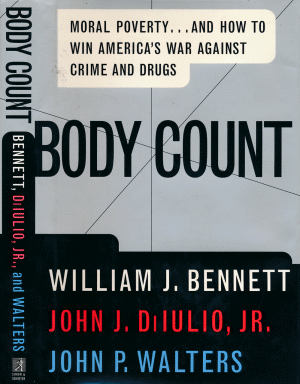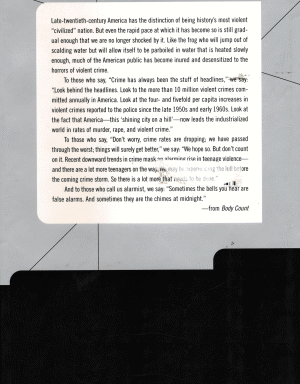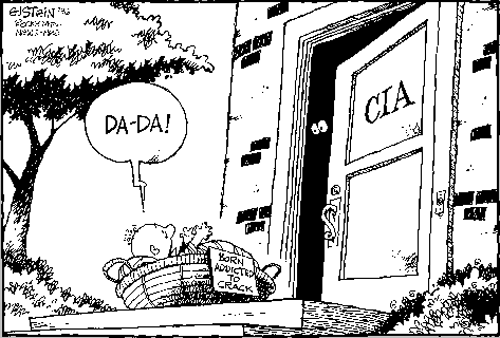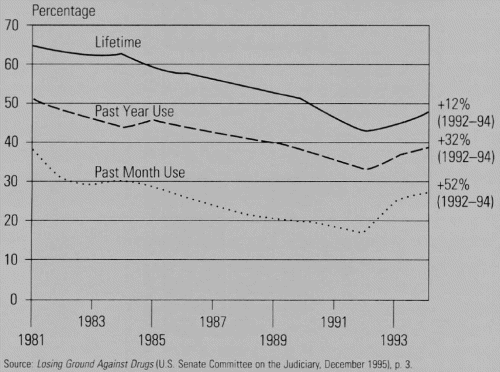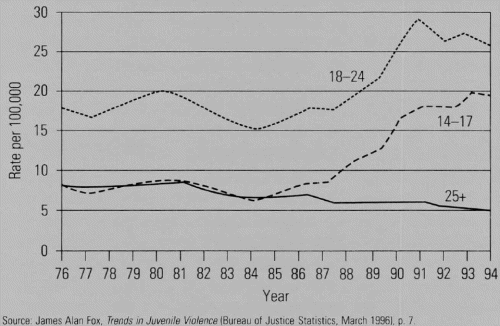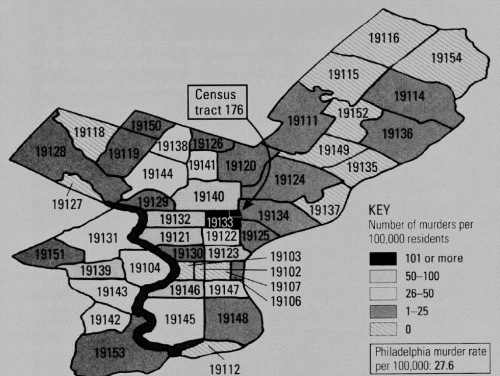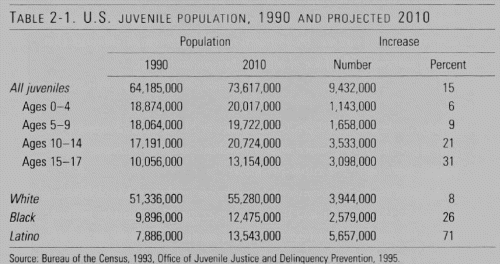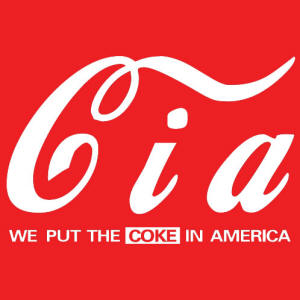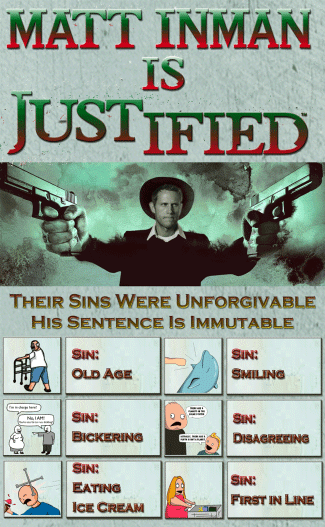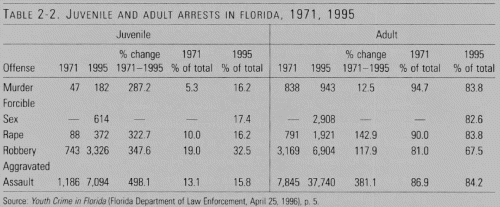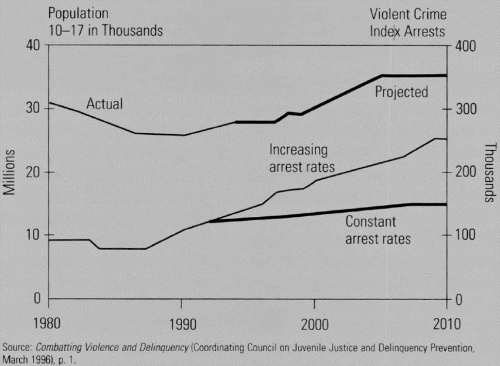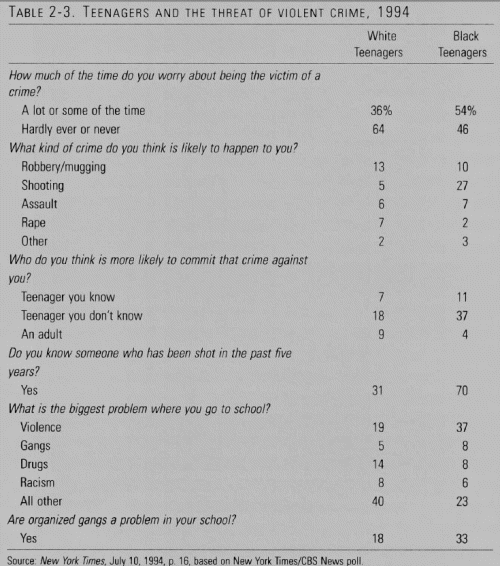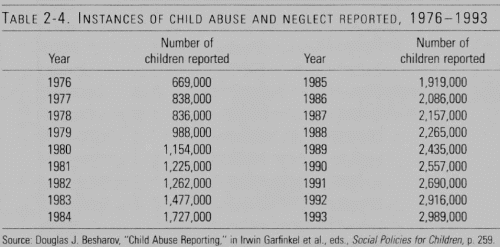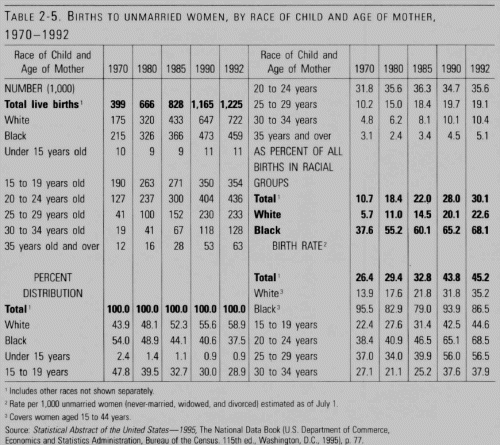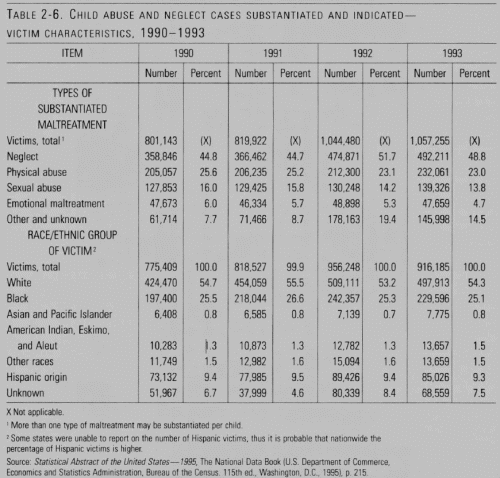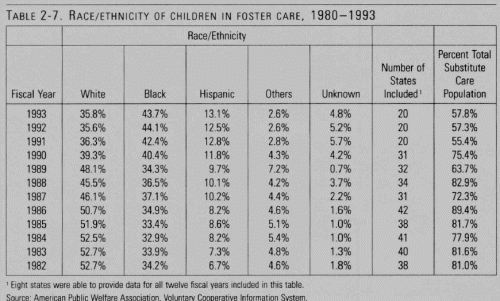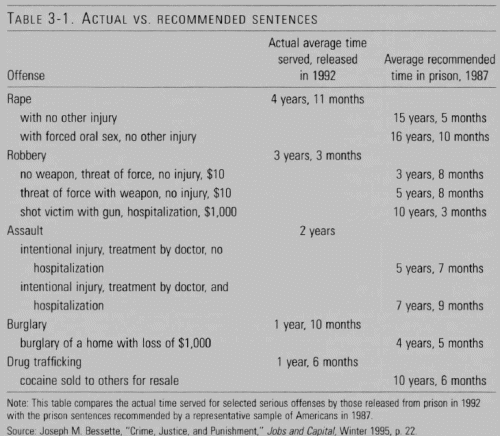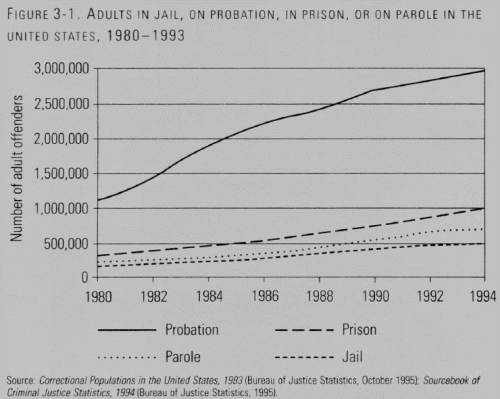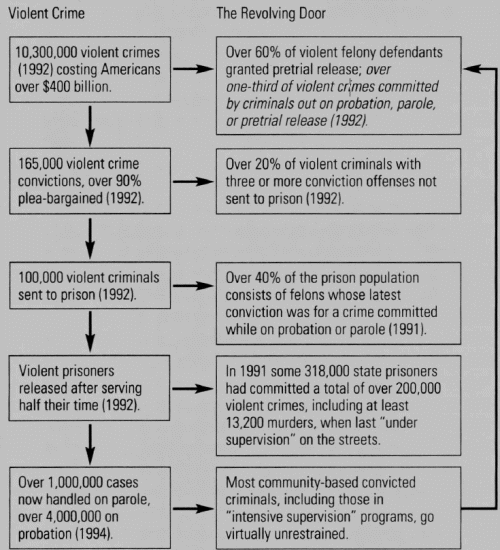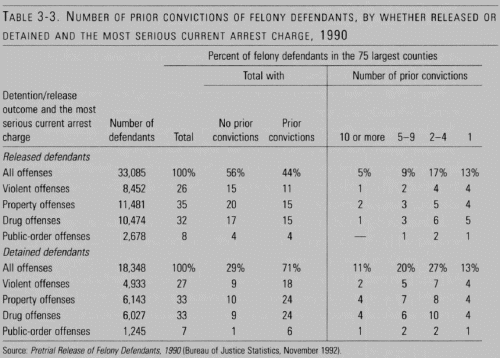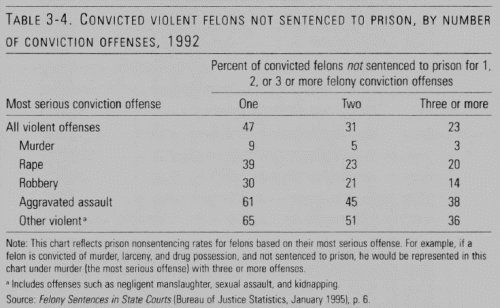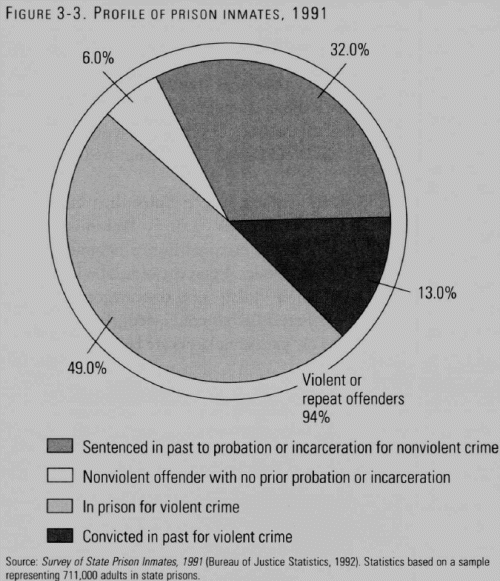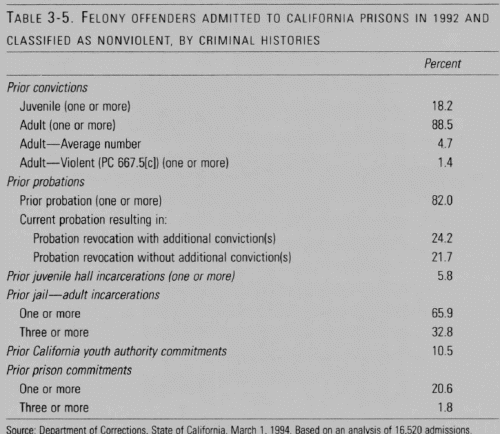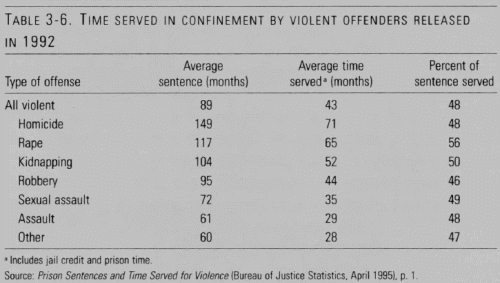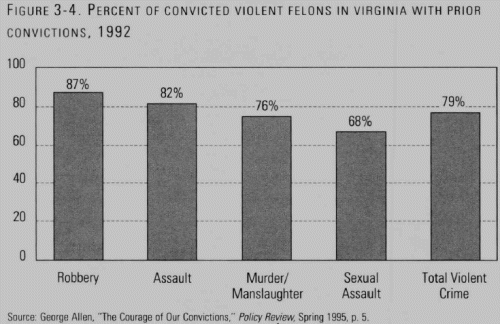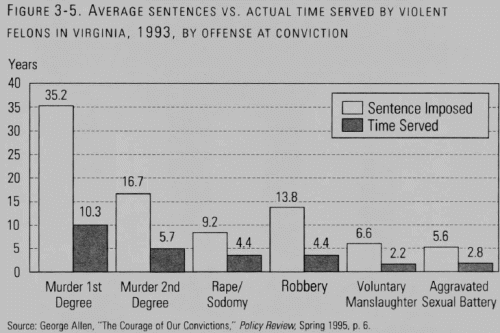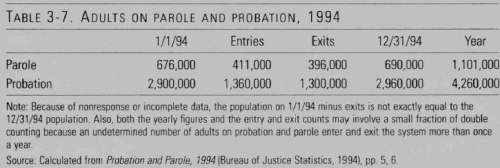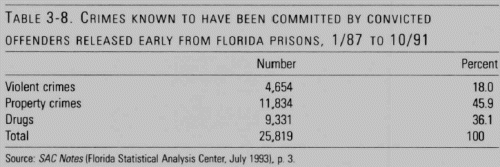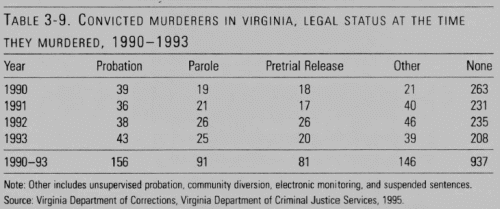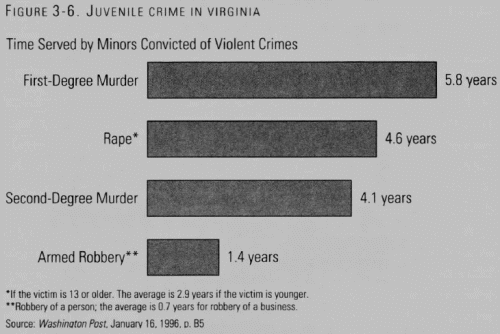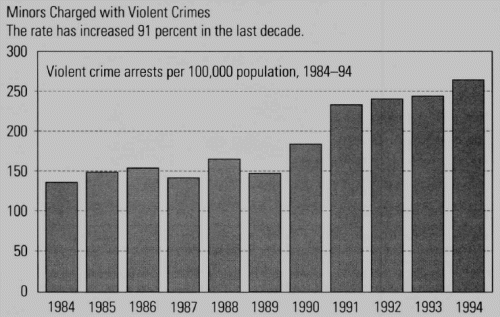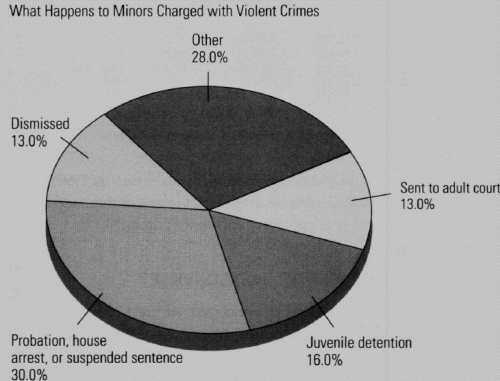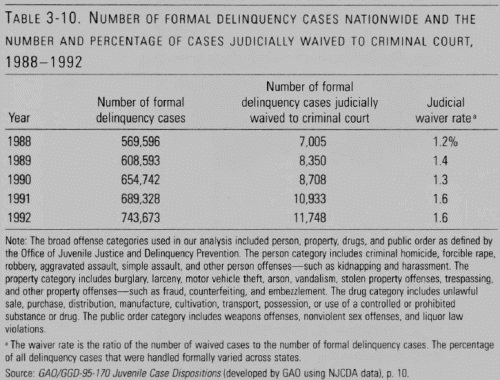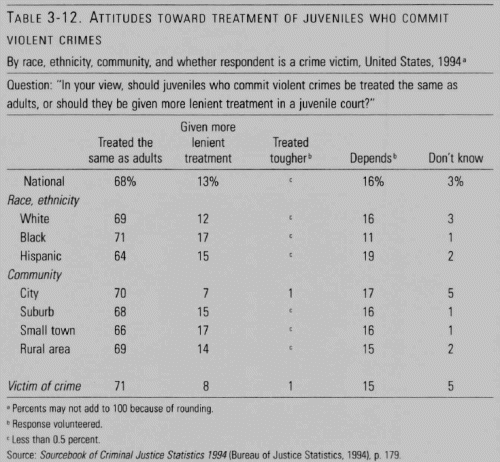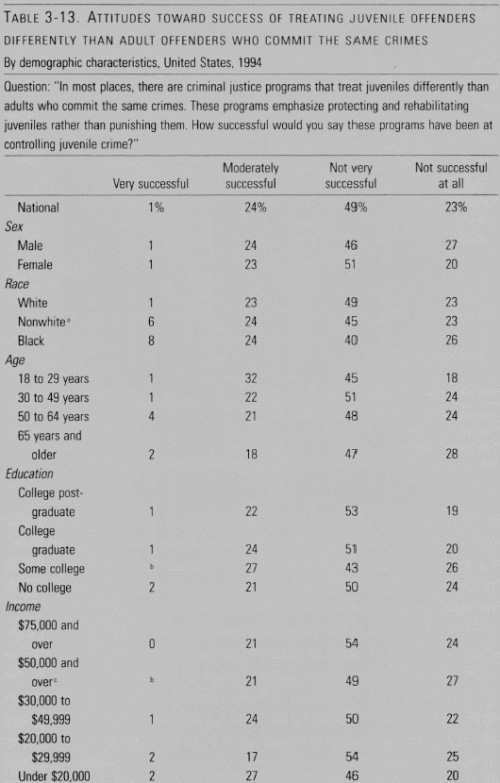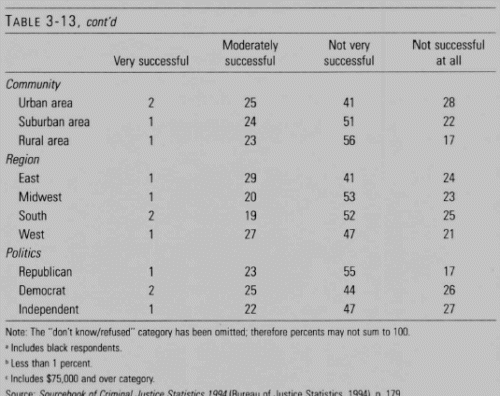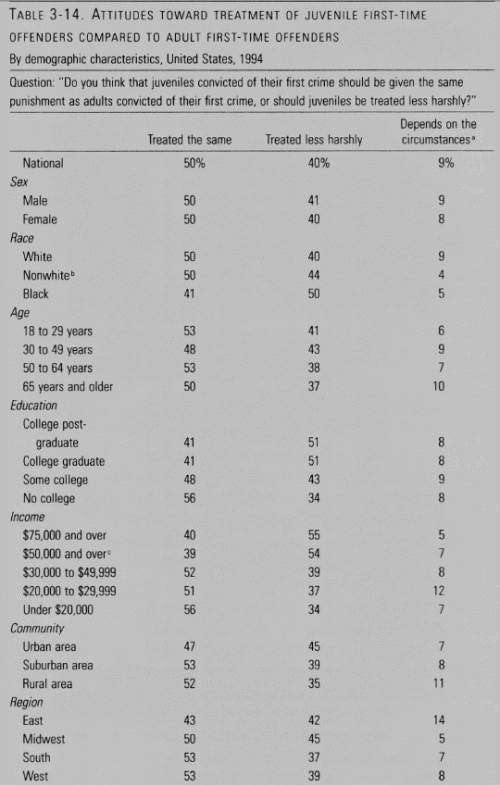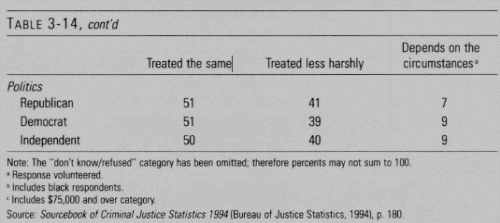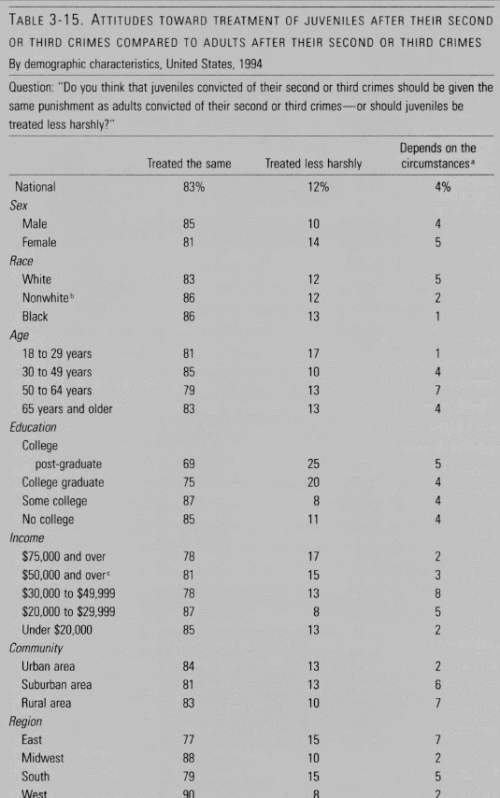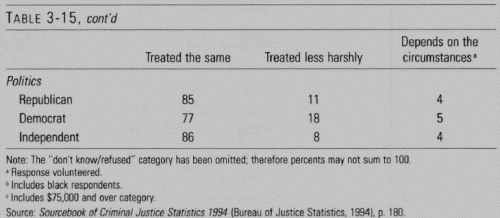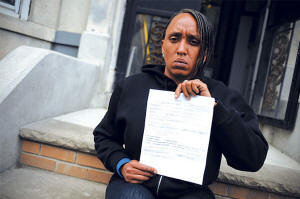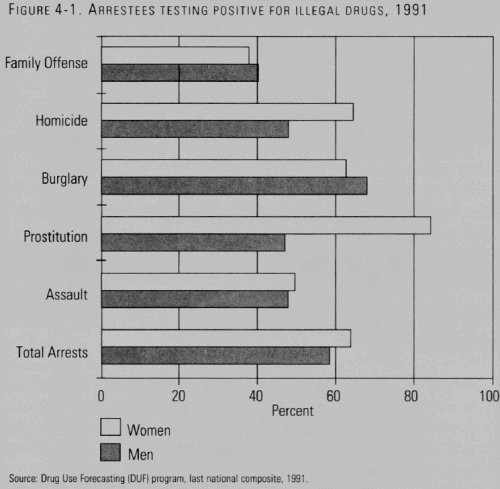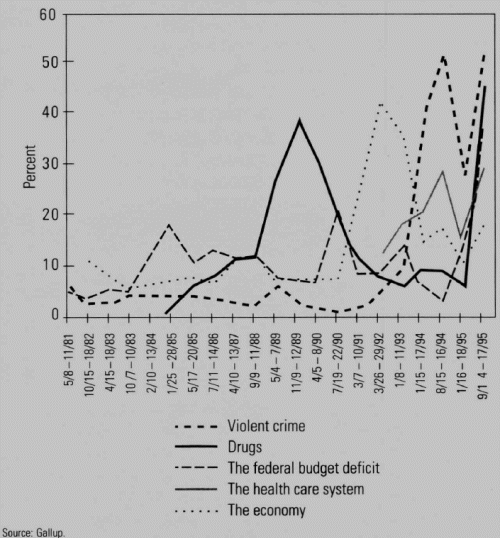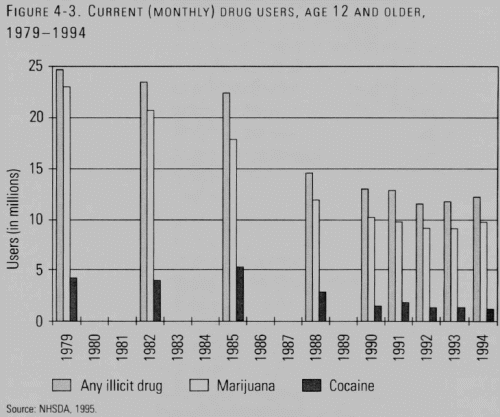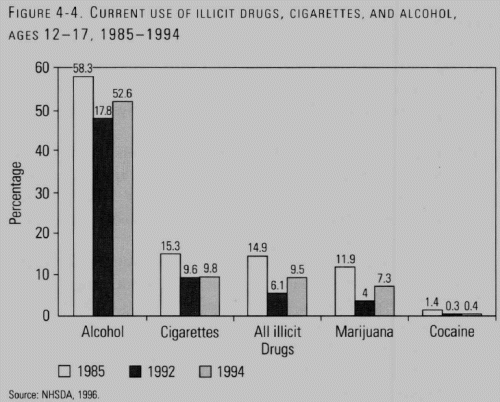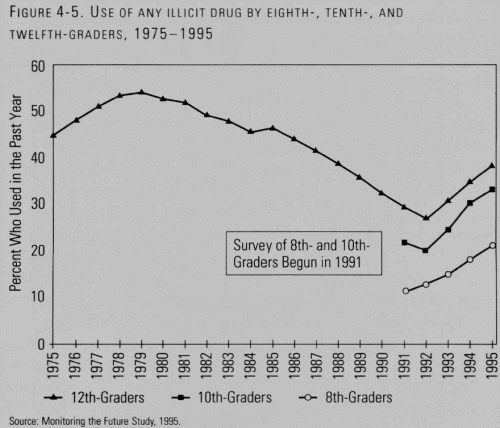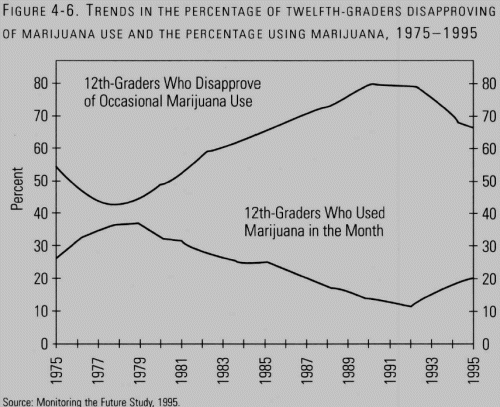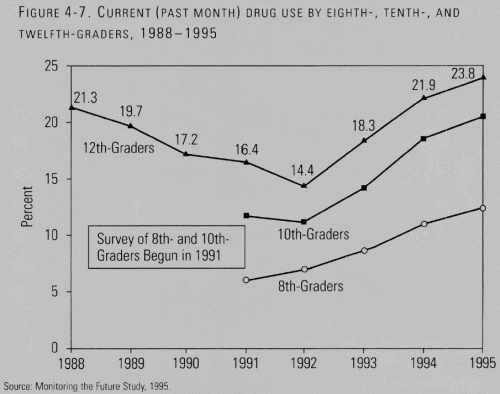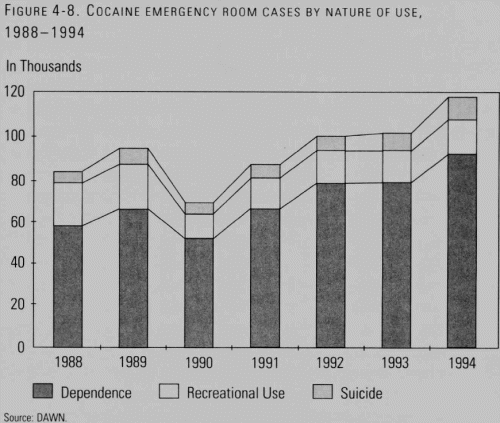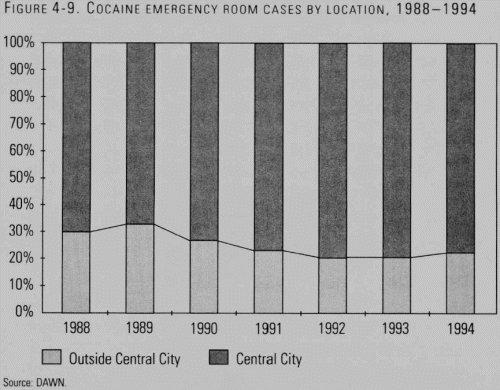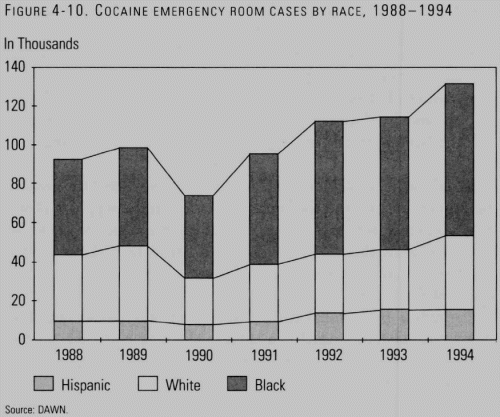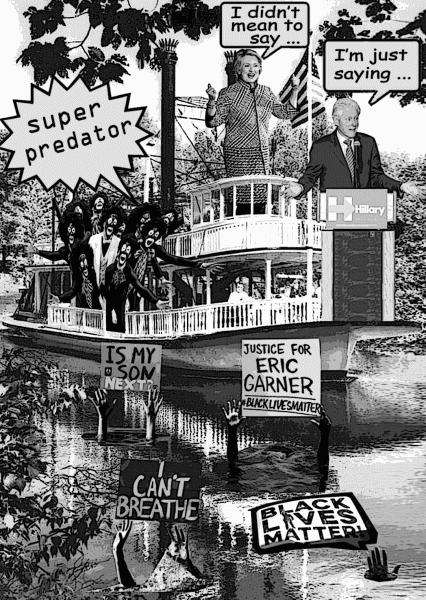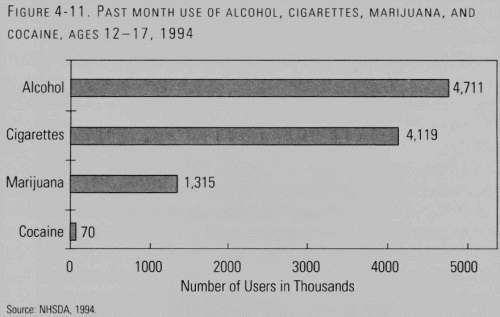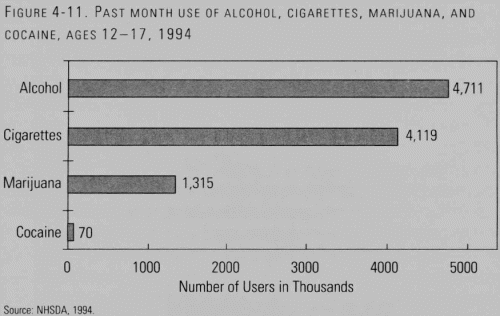Part 2 of 3
There is a perennial invasion of barbarians who must somehow be civilized and turned into contributors to the fulfillment of the various functions requisite to societal survival. ... The increase in the magnitude of the socialization tasks in the United States during the past decades was completely outside the bounds of previous experience. [59]
Thus, in the 1960s, America's primary socializing institutions -- families, schools, churches, and others -- were swamped by huge increases in the juvenile population. And, as Wilson perceptively argued, these institutions were starting to crumble at the very moment when they were needed to be towers of socializing strength. This is not a happy precedent for predicting how our society, now enervated as it is by record rates of illegitimate birth, divorce, and related social problems, will cope with the next demographic bulge of juveniles.
3. The Collapse of Traditional InstitutionsThe contradiction regarding social control has been amplified by the near collapse of the traditional authority structure which was buttressing social control processes. The collapse is partly due to the disruptive effect of change, but it can also be viewed as the logical outcome of a general evolution of the relationship of the individual to society.
Everywhere in the West the freedom of choice of the individual has increased tremendously. With the crumbling of old barriers everything seems to be possible. Not only can people choose their jobs, their friends, and their mates without being constrained by earlier conventions, but they can drop these relationships more easily. People whose range of opportunities is greater and whose freedom of change also is greater can be much more demanding and cannot accept being bound by lifelong relationships. This is, of course, much more true for young people. It has further been compounded by the development of sexual freedom and by the questioning of woman's place in society. In such a context traditional authority had to be put into question. Not only did it run counter to the tremendous new wave of individual assertion, but at the same time it was losing the capacity which it had maintained for an overly long time to control people who had no alternatives.
The late sixties have been a major turning point. The amount of underlying change was dramatically revealed in the political turmoil of the period which forced a sort of moral showdown over a certain form of traditional authority. Its importance has been mistaken inasmuch as the revolt seemed to be aiming at political goals. What was at stake appears now to be moral much more than political authority—churches, schools, and cultural organizations more than political and even economic institutions.
In the short space of a few years, churches seem to have been the most deeply upset. In most of Europe, a basic shift was accelerated which deprived them of their political and even moral authority over their flocks and within society at large. The Catholic church has been hit the hardest because it had remained more authoritarian. Yet as opinion polls have shown, religious feelings and religious needs persist. They may even have been reactivated by the anxieties of our time so that eventually churches will be able to regain some of the ground they have lost. In order to succeed they will have to open up and abandon what remains of their traditional principles.
This may have been already achieved since the authoritarian pattern is vanishing. The crisis is much more apparent within the hierarchy than among the laity. Priests are leaving the churches at an increasing rate; they cannot be replaced, and those who stay do not accept the bureaucratic authority of their superiors and the constraints of the dogma as obediently as before. They are in a position to exact a much better deal, and they get it. Conversely, they feel less capable of exerting the traditional moral authority they maintained over laymen. It may be exaggerated to pretend that the age-old system of moral obligations and guidance that constituted the church has crumbled; it is still alive, but it has changed more in the last decade than during the last two centuries. Around this change the new effervescence that has developed may be analyzed as a proof of vitality. New rationales may emerge around which the system will stabilize. But it seems clear enough already that the traditional model, which had been for so long one of the main ideological strongholds of European societal structures, has disintegrated. This is certainly a major change for European societies. Such a model provided a basic pattern for the social order and was used as a last recourse for buttressing social control, even in the so-called laicist countries like France where the Catholic church was supposed to have only a minor influence. The impact of the basic shift of values will be widespread. Even the nonreligious milieus, which had maintained similar models of social control despite their opposition to the Catholic principles, will not be able to resist change any better even if at first glance they seem less directly affected.
Education as a moral establishment is faced with the same problem and may be the first example of this corresponding similarity between opposing traditions. Whatever philosophical influences were exerted over it in particular countries, education is in trouble all over Western Europe. It has lost its former authority. Teachers cannot believe anymore in their "sacred" mission and their students do not accept their authority as easily as they did before. Along with the religious rationale for the social order, educational authority does not hold firm anymore. Knowledge is widely shared. Teachers have lost their prestige within society, and the closed hierarchical relations that made them powerful figures in the classroom have disappeared. Routine makes it possible for the system to work and the sheer necessity and weight of its functions will maintain it in operation. But the malaise is deep. The dogmatic structure disintegrates; no one knows how to operate without a structure and new forms do not seem to be emerging. We are still in the process of destructuration where generous Utopias still seem to be the only constructive answers to the malaise.
Higher education, which has had a more spectacular revolution, may have been partly revived, but in many countries and in many disciplines it is still in chaos. European universities do not offer any kind of institutional leadership. They are not real institutions for their students. Very few teachers will be able to propose positive and non-ideological models of commitment to values which can be acceptable to students. Consequently, the universities' potential cannot be used as a stimulant for change in society and young people's energies are easily diverted toward meaningless and negative struggles.
Other institutions are also, if less severely, perturbed by this collapse of moral authority. Among them the army, at least in its roles as training school for organizational disciplines and symbol and embodiment of patriotic values, has lost its moral and psychological appeal. Defense may be more and more entrusted to professional armies that may remain reliable. But the conscript army as a school for the citizen and as a model of authority is on the wane. It has lost all sense of purpose. It is really isolated from the mainstream of human relationships. Thus, another stronghold of the moral fabric of Western societies disappears.
-- THE CRISIS OF DEMOCRACY: REPORT ON THE GOVERNABILITY OF DEMOCRACIES TO THE TRILATERAL COMMISSION, by Michel J. Crozier, Samuel P. Huntington, Joji Watanuki
Indeed, Wilson's comprehensive analysis of crime in the 1960s may prove sadly prophetic for the 1990s and the first decade of the next century:
There is, perhaps, a "critical mass" of young persons such that, when that number is reached, or when an increase is sudden and large, a self-sustaining chain reaction is set off that creates an explosive increase in the amount of crime, addiction, and welfare dependency. What had once been relatively isolated and furtive acts (copping a fix, stealing a TV) became widespread and group-supported activities. [60]
Increasingly, the "widespread and group-supported activities" of today's juvenile criminals include not just using drugs and stealing but assaulting and senselessly killing.
In a masterful work he co-authored with Professor Richard J. Herrnstein of Harvard University, Wilson summarized the best and latest scientific studies on criminal behavior in relation to a wide array of social, biological, and situational factors. [61] As we read it, their review of the literature indicates that while objective material circumstances apparently do play a role under some conditions, each of many different types of criminal behavior has many possible "root causes."
Economic poverty never stands alone as a determinant of crime, and deviant, delinquent, and criminal behavior never occurs in a social vacuum. Among all economic classes, including low-income people and the poor,
it is irritable, impulsive, and poorly socialized males who are most likely to commit crimes, and "after all is said and done, the most serious offenders are boys who begin their criminal careers at a very early age." [62] Even early intervention government programs like Head Start, which reach economically disadvantaged children early, actually do little to reduce crime and delinquency, least of all among children whose families have failed them. [63]
[There is a] nearly invisible relationship between unemployment and crime rates. Charting homicide since 1900 reveals two peaks. The first is in 1933. This represents the crest of a wave that began in 1905, continued through the prosperous '20s and then began to decline in 1934 as the Great Depression was deepening. Between 1933 and 1940 the murder rate dropped nearly 40%. Property crimes reveal a similar pattern.
-- DAVID RUBINSTEIN [64]
From slavery times until present, black families and churches helped people resist this insidious effect of oppression. How they did so is one of the most important things we have to think about here. We know already, from bitter experience, what happens when these crucial institutions can no longer play their vital role.... The failure to pass on the values that helped black Americans to survive not decades, but several centuries, of mistreatment is taking an awesome toll, especially among the young. In many urban neighborhoods today, random murder stalks the streets. The stray bullets of gang clashes and drug-related executions claim the lives of infants and passersby ... When a people has passed through hell and survived to curse the devil, why should they suddenly collapse just as they push aside its open gates? Can the answer be racism or economic deprivation? If so, how do we explain the fact that our ancestors endured racial and economic abuse that was arguably greater and more systematic than we face now, yet managed to resist self-destructive moral disintegration of the type that is killing our people today?
-- DR. ALAN L. KEYES [65]
RACIAL DISPARITIESRacism is an even less persuasive explanation for the present-day crime problem than poverty.
Tragically, it is true that until the second half of this century, America's criminal justice institutions, like many other American institutions, were guilty of discrimination based on race. Fortunately, however, the justice system, like the rest of American society, has come a long way.As a National Research Council study, published by the National Academy of Sciences, concluded, "Few criminologists would argue that the current gap between black and white levels of imprisonment is mainly due to discrimination in sentencing or in any of the other decision-making processes in the criminal justice system." [66]
Once one controls for such characteristics as the offender's criminal history or whether an eyewitness to the crime was present, racial disparities melt away. To cite a typical example, a 1991 RAND Corporation study of adult robbery and burglary defendants in fourteen large urban jurisdictions across the country found that a defendant's race or ethnic group bore almost no relation to conviction rates, disposition times, or other key outcome measures. [67]
Rand Corporation: CIA front; involved in intelligence projects, weapons development, and underground bases development.
-- To Be A Hero, Stolen Honor: Inside the FBI, CIA and the Mob: The True Story of an FBI Agent, US Army Lieutenant Colonel, A Decorated War Hero, his life with the Bureau, the CIA and the Mob, as told by Col. Richard Maurice Taus, written by David Richard Taus
In 1980, 46.6 percent of state prisoners and 34.4 percent of federal prisoners were black. As the prison population increased during the 1980s, the percentage of it that consisted of blacks changed little. By 1990, 48.9 percent of state prisoners and 31.4 percent of federal prisoners were black.
Compared to white prisoners of the same age, black prisoners were more likely to have committed crimes of violence. In 1988 the median time served in confinement by black violent offenders was 25 months, versus 24 months for white violent offenders. For crimes of violence, the mean sentence length for whites was 110 months versus 116 months for blacks, while the mean time served in confinement differed by only 4 months (33 months for whites versus 37 months for blacks). [68]
At the federal level, a 1993 study showed that the imposition between 1986 and 1990 of stiffer penalties for drug offenders, especially crack cocaine traffickers, did not result in racially disparate sentences. The amount of the drug sold, the seriousness of the offenders' prior criminal records, whether or not weapons were involved, and other characteristics of offenses and offenders that federal law and sentencing guidelines establish as valid considerations in sentencing decisions accounted for all of the observed variations in imprisonment sentences. [69]
Similarly, a recent analysis of data representing 42,500 defendants in the nation's 75 largest counties finds "no evidence that, in the places where blacks in the United States have most of their contacts with the justice system, the system treats them more harshly than whites." [70] The same species of conclusion holds firmly for the death penalty. As a recent review of the scientific literature demonstrated beyond a reasonable doubt,
once one controls for all relevant legal and other variables, there is simply no systematic evidence of racial disparities in post-1972 capital sentencing. [71]In short, the best available research indicates that race is not a significant variable in determining whether a convicted adult offender is sentenced to probation or prison, the length of the term imposed, or how prisoners are disciplined. [72]
What, then, is one to make of the widely reported reality that a third of black men in their twenties are under some form of correctional supervision today (about one-third of them in prison or jail, the rest on probation or parole)? The same, we think, that one should make of the fact that
blacks are about 50 times more likely to commit violent crimes against whites than whites are to commit violent crimes against blacks. [73] Both sad statistics originate largely in the fact that
young black males commit crime at higher rates than do young white males. For example, "although blacks have constituted approximately 12 percent of the nation's population, they have accumulated 50 to 60 percent of the arrests for criminal homicide, about 50 percent of the arrests for forcible rape, close to 60 percent of the arrests for robbery, and between 40 and 50 percent of the arrests for aggravated assault." [74]
Blacks have been "responsible for a disproportionate amount of serious violent crime." [75]
As our colleague on the Council on Crime in America John W. Gillis has stressed, the rap sheets of convicted black drug dealers and violent felons are punctuated with crimes reported by and committed against other blacks. Gillis, a black veteran police officer and parole chief, is right. He does not argue -- nor do we -- that there is absolutely no racism in America or inside the justice system. That would be ridiculous. The point is not that "there's no racism."
The point is that racism does not even begin to explain racial disproportionalities in the system; real differences in crime rates do.Here's a suggestive calculation. [76] In 1991, 372,200 black men were in prison, along with 363,600 white men. About 60 percent of all prisoners in 1991 had committed one or more violent crimes in the past. Suppose that we released 40 percent of the black prisoners -- the 40 percent, say, with either no official history of violence or the least severe records of it. That would leave 223,320 black men behind bars. Then, because slightly more than half of the violent crimes committed by blacks are committed against whites, let's release, say, 55 percent of the remaining black violent male offenders. That would leave 100,494 black males in prison, 27 percent of 1991's actual total. They would be doing time with 3.6 times as many white males. But since whites in the general population still would outnumber blacks by roughly eight to one, the racial "disproportionality" would persist. To make it disappear completely -- to get an eight-to-one white-black ratio in prison -- we would have to release all but 45,450 of the 372,200 black men in prison in 1991.
Similarly, 605,062 black adults were on probation in 1993, compared with 1,132,092 white adults, and 240,767 black adults were on parole, compared with 236,083 white adults. Thus, the total black adult community-based corrections population (probation plus parole) numbered 845,829, compared with 1.37 million whites.
Let's say we believed that fully 70 percent of all black probationers and parolees, but none of the white ones, were innocent victims of a racist "war on drugs" and should never have been arrested. That would leave 253,749 black adults on probation and parole. We would still have only 5.3, not eight, times as many white adults as blacks "in custody" in the community. To eliminate entirely the racial "disproportionalities" in probation and parole, all but about 170,000 of the more than 800,000 black adults under community-based supervision in 1993 would have to be expunged from the rolls.
Nonetheless, it would be odd if black Americans were not ambivalent about the justice system. After all, blacks have been, and continue to be, singled out and treated unfairly for such "crimes" as "DWB" (driving while black). [77] We all know this happens, and, as Americans, we all must feel deeply ashamed and work to see that it stops, here and now, once and for all.
By the same token, it is again worth stressing that differences in crime rates reflect differences in social circumstances and socializing influences. As we will discuss a bit later in this chapter, the disproportionate number of black children who commit crimes is largely traceable to the disproportionate number of black children who grow up without two parents, and who suffer abuse and neglect.As we will document in the next two chapters, if the system is racist in any true sense of the word, it is racist in that it permits the black body count to mount so high by allowing known, adjudicated violent and repeat criminals to find fresh victims as they circulate in and out of custody, and by doing so little to combat drug trafficking. For no Americans suffer more from revolving-door justice and anemic antidrug policies than do black Americans, solid majorities of whom strongly oppose legalizing drugs and favor incarcerating violent and chronic criminals, adult and juvenile.
Henry's mother swears she has not used cocaine in three weeks, but her good pink suit cannot hide the shaking in her voice and the twitches in her body as she begs juvenile court Judge Cheryl Allen Craig for her children's return. Her 13-year-old son, slumped in a chair between his younger brother and his lawyer, has his own troubles. "Henry" (not his real name) has helped adult friends commit a burglary, regularly ditches his after-school probation program and has been shot twice, the last time at Christmas. Craig keeps Henry in a cousin's care and orders Pittsburgh police to take him to the juvenile jail if he misses curfew. "I'd rather have you be an angry, alive child than a dead child," she says .... Three days a week, children come to answer charges that they have committed a crime. On the other two days, the court hears cases of child abuse and neglect and of parents needing help controlling their children ... Police accustomed to picking up 16- and 17-year-olds are now attesting 12- and 13-year-olds. [78]
THE USUAL SUSPECTS: SOME CONSERVATIVE FALLACIESThe usual liberal explanations relating to poverty and racism fall far short of explaining the body count. But that does not mean the body count explanations of some conservatives -- relating to prisons (make them tougher), executions (make them more certain for capital crimes), guns (make them more widely available to law-abiding citizens), and legal loopholes (close them) -- are correct, complete, or realistic.
1. More "No-Frills" Prisons: Less Crime and Delinquency?For most of American history, prisons were hellholes.
In the twentieth century, prisons became more humane. Today, prisoners enjoy a wide variety of constitutional and legal rights. While some federal and state prisons have been terribly "overcrowded," at the end of 1994 thirteen states had more prison beds than prisoners. [79] The relationship between "overcrowding" and inmate violence, illness, and other problems is by no means as simple as it might seem. [80] Many dedicated and competent prison managers have run overcrowded prisons without any increases in such problems. [81] Moreover, as the nation's prison stock has grown, an ever larger fraction of all prisoners has been housed in new, well-designed minimum- and medium-security facilities, not old, dungeon-like maximum-security structures. In many states half or more of every prison dollar is now spent not on custody or security basics but on prisoner medical services, education, "treatment programs," and other functions. [82] Over 90 percent of prisoners enjoy some type of training, program activity, or work assignment. [83]
Some conservatives believe that prisons coddle criminals, and that toughening prison conditions is a key to cutting crime.
We would certainly agree that some prisons are virtual resorts. [84] And while we are persuaded that certain types of no-nonsense prison-based programs are definitely worthwhile (if only as prison management tools or intrinsic aspects of humane confinement), we would also agree that the empirical evidence in support of the rehabilitative value of most prison-based programs remains mixed, anemic, or nonexistent. [85]
There are, to be sure, good moral and cost-effectiveness arguments for scaling back prisoner amenities and services. After all, why in the world should violent and repeat criminals enjoy at taxpayer expense educational programs, health plans, recreational equipment, and other benefits that many law-abiding citizens can hardly afford for themselves and their children?But it is, we believe, a mistake to think that "no-frills" prisons are the answer to crime and delinquency. Remember: most criminals don't expect to get caught, convicted, and locked away in the first place. Many felons think little about the risks of going to prison, and even less about likely conditions of confinement should they prove so "unlucky." One study, for example, found that half of state prisoners convicted of a crime that carried a mandatory prison term did not know the penalty structure at the time they did the crime; half of those who didn't know said they would have done the crime even if they had. [86] Likewise, a recent ethnography of "persistent thieves" by Professor Neal Shover reveals that "young offenders know little and care less about the schedule of penalties .... Juveniles and young adults often have little awareness or appreciation of the legal and personal repercussions of their criminality." [87] As one subject said, when he was young he "just didn't give a fuck, you know. I was young, simple, man .... Doing time to me was nothing, you know." [88]
It is, therefore, a bit fanciful to suppose that many violent and career criminals, least of all the young ones, would respond to the threat of more spartan prison conditions by ceasing to behave like street gladiators. Few street criminals would forgo the immediate pleasures of crime (sex, drugs, money) in order to avoid the future deprivations of a "no-frills" prison life -- no cable television, no barbells, no Pell education grants.
Of course, forcing those who do end up behind bars to do long, hard time would undoubtedly avert crimes and increase the marginal deterrence value of prisons. But we know of no evidence to suggest that doing so would deter the young, impulsive army of youth predators about whom we are most concerned. As we will explain in the next chapter, despite recent "get tough" policy changes, only a tiny fraction of all criminal victimizations results in a prison term.
Thus, whatever the moral or cost-effectiveness rationales for taking excessive amenities and services away from incarcerated felons (and we sympathize with these rationales), eliminating prison "frills" ought not to be viewed as a practical or moral substitute for ending revolving-door justice. And to those who insist that a return to such practices as chain gangs and the rock pile are our only hopes, we commend a prison library full of books on the racially polarizing legacy of such obsolete and discredited approaches.
2. Death Penalty: Symbolism vs. Substance [89]Between 1977 and 1993 a third of a million Americans were murdered. Now take this multiple-choice test and guess what happened to their killers:
1. How many people were on death row in 1993 for all those lives stolen since 1977?
(a) 58,590
(b) 14,152
(c) 2,716
2. How many of the thousands of individuals on death row in 1993 were actually put to death that year?
(a) 491
(b) 164
(c) 38
3. Between 1977 and 1993, how many murderers do you suppose were executed in America in total?
(a) 22,600
(b) 2,260
(c) 226
4. What is the average sentence these days of someone in state prison for murder?
(a) 40 years
(b) 30 years
(c) 20 years
5. How much time does the average murderer actually spend in lockup before being released?
(a) 21 years
(b) 14.7 years
(c) 8.5 years
The correct answer to each question is "c." Which means that our justice system's message to anyone who believes murder should be punished by the death penalty is currently something like: "Get lost!"
In recent years, no state has executed more murderers than Texas. In 1993 Texas carried out 17 capital punishments; Virginia was a distant second with five. But Texas, like other states, had commuted all death sentences to life imprisonment after the Supreme Court abolished the death penalty in 1972, and a recent study by Professor James W. Marquart tells us what happened to those death row inmates when Texas stopped executing them. [90] It reveals that since 1974 about three times as many Texas prisoners have been released from death row by commutation or judicial reversals or dismissals as have been executed. After being released into the general prison population, 12 of 47 commuted prisoners were responsible for 21 serious violent offenses against other inmates and prison staff. One commuted death row inmate killed another prisoner. And within a year of his release on parole, another commuted death row prisoner killed a girl.
This is not to say that every murderer on death row would murder again if released. But these individuals do tend to be repeat criminals. Over 40 percent of the persons on death row in 1992 were on probation, parole, or pretrial release at the time they murdered.
One of the things that has obstructed and delayed the carrying out of death sentences most is fear that they might be handed out in racially unfair ways. There are scores of studies that test this by weighing racial factors in capital sentencing. As noted earlier in this chapter, those studies that control for all relevant factors including crucial legal variables (eyewitnesses present, aggravating circumstances) find
absolutely no evidence of racial bias in contemporary capital sentencing. Of those persons under sentence of death in 1993, about 58 percent were white. This is actually much higher than the proportion of all murderers who are white.
No matter what type of realistic reforms might be adopted to reduce the endless legal appeals that currently block most death sentences from being completed, America is never going to make it easy or inexpensive to execute convicted killers. Besides, the real bottleneck discouraging use of the death penalty today is not at the back end, it's at the front end: prosecutors wary of controversy don't seek the death penalty if they can help it, least of all in racially charged cases. When the Supreme Court terminated the death penalty in 1972, murder cases fell into the plea-bargaining pit along with other violent crimes. When the Court reinstated the death penalty in 1976, prosecutors were not eager to pull it out. Today, the bureaucratic, mass-assembly culture of most big-city district attorney's offices favors doing a little deterrence on the cheap, and frankly, not a lot of justice at great effort and financial cost.
Every major opinion survey of the last decade shows that majorities of Americans -- whites, blacks, young and old alike -- support the execution of murderers. Americans value the death penalty not just for its utility as a crime-reduction tool but also as a way of doing justice. Only a tiny fraction of even the most vicious killers ever get executed. Neither deterrence nor justice can possibly be achieved in this way.
CAPITAL PUNISHMENT IS LESS POPULAR THAN THE ALTERNATIVESIt is commonly reported that the American public overwhelmingly approves of the death penalty. More careful analysis of public attitudes, however, reveals that most Americans prefer an alternative; they would oppose the death penalty if convicted murderers were sentenced to life without parole and were required to make some form of financial restitution. In 2010, when California voters were asked which sentence they preferred for a first-degree murderer, 42% of registered voters said they preferred life without parole and 41% said they preferred the death penalty. In 2000, when voters were asked the same question, 37% chose life without parole while 44% chose the death penalty. A 1993 nationwide survey revealed that although 77% of the public approves of the death penalty, support drops to 56% if the alternative is punishment with no parole eligibility until 25 years in prison. Support drops even further, to 49%, if the alternative is no parole under any conditions. And if the alternative is no parole plus restitution, it drops still further, to 41%. Only a minority of the American public would favor the death penalty if offered such alternatives.
-- The Case Against the Death Penalty, by American Civil Liberties Union
In our view, there is a moral case for the death penalty, and for preventing duly-convicted killers from seeking one appeal after another. But there is not a chance that the death penalty in America can be retrieved from symbolism and made into a substantive tool of crime control. Conservatives who hope to reduce the body count by increasing or speeding executions are bound to be mightily disappointed.
3. Guns: Straight Shooters? [91]
As the nation's big-city police know all too well, much inner-city crime, especially the murderous violence wrought by drug-financed street gangs, involves guns. In the 1980s the Fraternal Order of Police became a principal voice in support of strict gun control measures. Between 1981 and 1994, such proposals as a week long waiting period for the purchase of handguns sparked intense constitutional arguments in Congress and frantic lobbying efforts behind the scenes by groups opposing and favoring gun control. Unfortunately, however, there is little empirical knowledge about the crime reduction effects of such measures. Police and other proponents of gun control measures were unable to muster much systematic evidence in support of their position because such evidence simply did not exist.
In 1981 the Attorney General's Task Force on Violent Crime recommended measures that would tighten controls on gun ownership and require states to adopt a mandatory waiting period to allow for a records check to see whether a prospective handgun buyer had a criminal history. [92] This Reagan administration proposal, and the gun control bills that have since been debated in Congress, were commonsense responses to the fact that many crimes, including about 60 percent of all murders, involve firearms. Moreover, in every year since 1972, at least 70 percent of the general public has favored some gun control measures. The movement in favor of gun control that grew up around the efforts of former White House spokesman James Brady, who was shot in the 1981 attempt on President Reagan's life, put the nation's most powerful opposing group,
the National Rifle Association, on the defensive.
The question, however, is how efficacious such measures are likely to be in reducing gun-related crime. Nobody knows the number of guns held privately in this country. Some have estimated at least one-fifth of American homes have guns. [93] Numerous federal, state, and local laws already regulate the manufacture, sale, and use of most firearms. What, if anything, additional federal laws add to the crime reduction effects of the existing battery of state and local laws remains unclear.
Despite the paucity of meaningful evidence, both liberals who favor gun control and conservatives who oppose it continue to make sweeping generalizations about what works and what doesn't. For example, some pro-gun-control advocates have already pronounced the Brady Bill a major success. Never mind that the information systems needed to implement the law have been slow to develop. Meanwhile, some anti-gun-control advocates have already applauded the success of "shall issue" concealed-weapons laws that extend gun permits to any of-age applicant who's not a convicted felon or mental outpatient. Never mind that there has yet to be a systematic study of the effects of these laws in the twenty-eight states that had adopted them as of early 1996.
To be frank, neither side in the gun control debate has been shooting entirely straight with the facts and figures. There are important truths on both sides. For example, we fail to see any argument for permitting easy access to assault weapons. By the same token, however, we accept the evidence, amassed mainly by Professor Gary Kleck, which indicates that the vast majority of citizens who possess guns do no harm to themselves or others, and often succeed in using their weapons to foil criminal mischief against their persons and property. [94]
If more (or fewer) guns is the answer, then precisely what is the question? More (or fewer) guns in whose hands under what conditions?
Conservatives who insist that a libertarian approach to guns is best needed to explain how putting more guns in the hands of more juvenile super-predators won't further increase the body count. Of course, they can't, because putting more guns in those hot, hair-trigger hands would only bring more death.We agree with Professors Mark H. Moore and Philip J. Cook when they write that the "goal of gun control policy over the next decade should be to develop and evaluate specific gun control measures that can reduce gun crimes, suicides, and accidents, while preserving as much legitimate use of guns as possible a portfolio of policies that reflects the full array of gun 'problems' [and] differ[s] according to local circumstances and values." [9]
Our view, then, is that gun control cannot reverse crime trends; those who argue that gun control legislation is the most important step we can take to reduce crime -- and hence ought to be the centerpiece of anti-crime legislation -- are simply deluding themselves. At the same time, we believe that some gun control laws can make a small positive difference -- and so we believe they are well worth doing.
Specifically, we support the eminently reasonable provisions of the Brady bill. Laws that succeed in restricting the circulation of guns to criminals are bound to have a positive effect -- and in fact, they do.4. Blame It on Miranda?The last in our lineup of usual suspects are the legal loopholes that conservatives love to hate -- exclusionary rules that prohibit illegally seized evidence from being used in criminal trials; unlimited appeals by felons who have been tried and convicted many times; and procedural requirements such as the Miranda rule, which makes even a voluntary, uncoerced confession by a suspect who hasn't been read his rights inadmissible in court.
The United States Supreme Court issued its Miranda decision on June 13, 1966. The court held that under the Fifth Amendment ("No person ... shall be compelled in any criminal case to be a witness against himself"), the police must inform a suspect that he has the right to remain silent, warn him that anything he says might be used against him in court, and tell him that he has the immediate right to a lawyer (a defender provided at public expense if he can't afford one).
As one thoughtful conservative critic of Miranda, Robert James Bidinotto, has noted, should "the police make the slightest omission or error in this ritual, any evidence they get can be thrown out, and the suspect can 'walk.'" [96]
There can be no question that in a number of cases justice is delayed or denied because of Miranda and Miranda-style legal loopholes. But how many cases, and with what overall impact on crime? The highest estimates have been made in two recent articles by Professor Paul G. Cassell. He finds that about "3.8 percent of cases are lost due to Miranda," a total which includes about "28,000 arrests for serious crimes of violence and 79,000 arrests for property crimes ... and almost the same number of cases are disposed of on terms favorable for defendants." [97]
Even if one took these estimates at face value, it would be hard to know what they mean. As Cassell himself explains, "We have little knowledge about what police interrogation looked like shortly after Miranda, much less what it looks like today. How many suspects waive their Miranda rights? How many confess?
How important are confessions to the outcome of prosecutions? Even the most informed observers can offer little beyond speculation on these fundamental subjects." [98]
No one can say for sure how, if at all, police might perform better if they did not have to "Mirandize" suspects. Likewise, while
relaxing exclusionary rules on evidence and curtailing prisoner appeals are desirable for the sake of justice, just how much lower would the body count be if illegally obtained evidence were routinely admitted in court and the appeals process was short-circuited?
That counterfactual question will never be answered. We can trim the pro-criminal, pro-prisoner excesses of the present-day system, but we will quickly discover that only minor changes are possible lest we wish to tinker with the Bill of Rights. As UCLA's Wilson has reminded us, Americans "have preserved and even extended the most comprehensive array of civil liberties found in any nation on earth despite rising crime rates and (in the 1960s) massive civil disorder." The price of our "wide-ranging bill of rights" includes "a willingness both to accept a somewhat higher rate of crime and disorder than we might otherwise have and to invest a greater amount of resources in those institutions (the police, the prosecutors, the courts, the prisons) needed to cope with those who violate our law while claiming its protections." [99]
Thus, even if we enacted such reasonable measures to close legal loopholes as are politically feasible -- and we think we should -- the body count would still mount.
Participation in East Jersey State Prison's "Lifers' Group" doesn't shorten any inmate's sentence .... What it does, and has done for 20 years, is give inmates who have essentially thrown away the bulk of their lives the chance to make a difference in the lives of complete strangers, a chance to keep some kid from making the same mistakes the Lifers themselves have made ... The Lifers' confrontational, almost brutal, method of bringing home the reality of prison life quickly gained notoriety around the country. The program was captured on the Oscar-winning 1978 documentary film, "Scared Straight." ... And the kids are getting harder and harder to "scare straight." Lt. Randall Sandkuhl, a corrections officer who works with the Lifers, said some of the young men and women who come in are already so hardened and tough they end up scaring the inmates. "You stand next to a kid in court and hear the judge sentence them to 40 years in prison without parole and they turn to you and say, 'What's for lunch, officer?' " Sandkuhl said. "They just don't care." [100]
THE TRUE CULPRITSo, if it's not the handicaps we've imposed on cops and prosecutors, and it's not institutionalized racism, and it's not material want, then what is the fundamental cause of predatory street crime?Moral poverty.Moral poverty mocks well-intentioned programs and fills no-frills prisons.
Moral poverty makes some young men pull triggers the way some old men fire off angry letters. Moral poverty unleashes more murderers in a single year than America has executed in this century. Moral poverty makes both racism and legal loopholes mere backdrops in a crime drama featuring family disintegration, child abuse, and child neglect. And moral poverty, not economic poverty, is what marks some disadvantaged youngsters for a life of drugs and crime while passing over others in equal or greater material distress.To repeat what we mentioned in Chapter 1:
moral poverty is the poverty of being without loving, capable, responsible adults who teach you right from wrong; the poverty of being without parents and other authorities who habituate you to feel joy at others' joy, pain at others' pain, satisfaction when you do right, remorse when you do wrong; the poverty of growing up in the virtual absence of people who teach morality by their own everyday example and who insist that you follow suit. In the extreme, moral poverty is the poverty of growing up severely abused and neglected at the hands of deviant, delinquent, or criminal adults.Whatever their material circumstances, kids of whatever creed, color, demographic description, socioeconomic status, region, or zip code are far more likely to become (pace West Side Story) criminally depraved when they are morally deprived.
The abject moral poverty that produces super-predators most often begins very early in life in settings where deep and abiding love is nowhere but unmerciful abuse is the norm. An extremely morally impoverished beginning early in life makes children vicious who are by nature merely aggressive, makes children remorseless who are disposed to be uncaring, and makes children radically impulsive who have difficulty sitting still, concentrating, and thinking ahead. In general, we believe, today's juvenile superpredators are children who, in order to be civilized and socialized into adulthood, would have needed a maximum dosage of moral tutelage from parents, teachers, coaches, clergy, and other responsible adults, but instead received either no such moral education, or were persistently exposed to its opposite by
adults who severely abused and neglected them, encouraged them to act out, and rewarded their antisocial words and deeds.The twin character scars left by moral poverty -- lack of impulse control and lack of empathy -- reinforce each other and make it far more likely that the individual will succumb to either the temptations of crime, or the blandishments of drugs, or, as so often happens, both. Once a morally impoverished individual has mixed crime with drugs, he is far more likely to go right on mixing them, and, in turn, pursuing whatever instant gratifications he desires (sex, money, laughs, "respect"), and at whatever human and financial cost to others (up to and including the sudden loss of their lives) it may entail.
Below we will flesh out some of the empirical evidence that we believe supports our theory of moral poverty, and justifies our confidence that its explanatory reach far exceeds the explanatory grasp of any and all of the usual suspects.
The flip side of moral poverty is moral health. Being born healthy to or raised by loving biological or adoptive parents or guardians of whatever race, creed, color, socioeconomic status, or demographic description is perhaps the luckiest fate that can befall a human being. To be born into or raised by such a family, and to grow up surrounded by loving, caring, responsible adults -- parents or guardians, neighbors, teachers, coaches, clergy -- is to be raised in moral wealth.
Children need the love, attention, and guiding discipline of loving, caring, responsible adults who are there to hug and scold, encourage and restrain, reward and punish in accordance with basic social norms governing how people should relate to one another -- speak respectfully to peers and authorities; use physical force against others only in self-defense; never simply to express anger for "the fun" of it; and so on.
To become civilized and socialized, let alone to be made cooperative and good-natured, all children need to be taught right from wrong by adults who, most if not all of the time, teach it by their own, everyday example.As every parent of more than one child knows, children differ in their personalities, temperaments, and sociability. Before they're out of diapers, some children seem to listen and cooperate almost without being told; others seem naturally disposed to go their own way; and a few behave like "untamed terrors." Generally speaking, and other things being equal, boys are a harder-to-tame, harder-to-socialize lot than girls, and some boys are naturally more irritable, more impulsive, and harder to control than others.
Thus, some children require more, and more persistent, adult guidance and supervision than others if they are to become good adults (at the outside) and refrain from wantonly harming other people or stealing their property (at a minimum). In any functional society, even most "untamed terrors" and "troubled teens" become good people. Most never even come close to being totally self-centered liars, thieves, domestic abusers, or violent predators. The reason is that along the way -- in homes, in schools, on playing fields, in churches, and elsewhere -- most receive the necessary doses of loving, caring, responsible adult guidance and supervision they need.
Of course, growing up nestled in a loving, stable, economically solvent two-parent family in a relatively drug-and-crime-free community is best, but it is by no means the only way for a child to accumulate the moral capital needed for a successful journey to adulthood.
For example, a recent study by Public/Private Ventures, the country's premier youth and community development research organization, examined 959 10- to 16-year-olds who applied to Big Brothers/ Big Sisters (BB/BS) of America. Just over 60 percent were boys, and more than half were minority group members (of those, about 70 percent were black). Almost all lived with one parent (the mother, in most cases), the rest with a guardian or relatives. Many were from low-income households, and a significant number came from households with a prior history of either family violence or substance abuse (in some cases both). Just the same, compared to otherwise comparable children not in the BB/BS program, Little Brothers and Little Sisters who met with their "Bigs" regularly for about a year were 46 percent less likely than their peers to start using illegal drugs, and 32 percent less likely than their peers to assault someone, not to mention less likely than their peers to skip school, get poor grades, or start drinking. [101]
The BB/BS example is but one of many powerful illustrations of the fact that, even among children who are well out of diapers, and even where the positive adult-child relationship happens as it does in BBI BS for only three to four hours three times a month, positive nonparental adult influences can make a positive difference in the lives of even the most at-risk youth.
The single most important body count, super-predator reality with which we are dealing, therefore, is that millions of children in America today are neither born into the bosom of loving, caring, responsible adults, nor given much in the way of positive adult supervision and guidance outside the home.
More and more children in this country are growing up not in moral wealth but in abject moral poverty.We assume that for a man to become good he must first be trained and habituated properly, and then go on to spend his time, in the spirit thus engendered, on worthy occupations, doing nothing base or mean, either willingly or unwillingly.
-- ARISTOTLE, THE ETHICS [102]
His home on the southwest side of Detroit was a crack house. His father used to beat his mother. Jacob saw his sister shot in the face when he was 4 or 5. His father was shot to death in a bar fight about the same time ... He has seen family members pull guns on one another ... He was 9 when he took his first drag of marijuana. An older sister gave it to him ... Court records show that [Jacob's mother] drank heavily, used crack and once even sold her children's clothes for drug money. She failed to show up at Jacob's first court hearings on the armed-robbery charge. She was drunk when she finally came to testify .... She did not even know her son's birthday. [103]
The empirical evidence to support our moral poverty theory of crime and delinquency is diverse, pervasive, and, we think, commonsensical. Our theory is that, ceteris paribus, the probability that a child will become a super-predator or adult career criminal varies inversely with the number and quality of positive and persistent adult influences in a child's life (parents, teachers, coaches, clergy, and others). Moral wealth breeds social health; moral poverty breeds crime and social decay.
For starters, consider the findings of several recent and sophisticated studies:
• In a major re-analysis of data from a classic study of crime and delinquency,
Robert J. Sampson and John H. Laub confirmed the primacy of family factors: "Despite controlling for these individual difference constructs, all family effects retained their significant predictive power.
And once again mother's supervision had the largest of all effects on delinquency, whether official or unofficial. A major finding of our analysis is that family process variables are strongly and directly related to delinquency ... family processes of informal social control still explain the largest share of variance in adolescent delinquency." [104]
• A study by Professor Daniel S. Nagin and others explored the relationship between adolescent motherhood and the criminality of her offspring. The study revealed a birds-of-a-feather phenomenon. About "25 percent of boys with criminal fathers also have a criminal mother, compared to 4 percent in the case of noncriminal fathers. Similarly, 67 percent of boys with criminal mothers also have a criminal father, compared to just 19 percent when the mother is not convicted .... Our results suggest that the children latest in the birth order of women who begin childbearing early are at greatest risk of criminality. This finding appears to reflect the coming together of the deleterious impacts of poor parenting and role modeling and diminished resources per child." [105]
• A study of "resilient youth" -- the half of all high-risk children who do not engage in delinquency or drug use -- by Professor Carolyn Smith and others indicates that child "maltreatment itself has for a long time been associated with problematic outcomes for children .... Considerable research in both criminology and child development suggests that family deviance, including criminality and substance abuse of family members, affects developing children because such parents are likely to tolerate and model deviance for children." [106]
• A National Institute of Justice statistical analysis found that maltreatment of children increased their chances of future delinquency and criminality by 40 percent. [107]
• In the most significant ethnography of urban street criminals published in over a decade, Professor Mark S. Fleisher concludes: "An abundance of scholarly research shows that anti-social and delinquent tendencies emerge early in the lives of neglected, abused, and unloved youngsters, often by age nine. My ethnographic data support these findings and show that, once these youngsters leave home and go on the street, they are at best difficult to extricate from street culture .... In 1991, 50 percent of an estimated 6.4 million nonfatal acts of violent crime were committed by these adolescents and young-adult street criminals." [108]
At age nine, Willie Bosket was in a state reformatory, the same reformatory that his father, Butch -- a man he never met -- had entered at age nine. There Willie assaulted, stole, and choked a nurse in the "Quiet Room." Lesser delinquents praised him: "Man, you real bad." At one point, he fought one of the men who kept company with his mother. His mother rarely visited him. Butch had been beaten by his father, James, who also sexually abused his grandson Willie. By age 15, Willie was shooting and robbing New York subway passengers. He killed two men in cold blood. Released after five years because he was technically still a juvenile, he did more crime, and in 1988 attempted to murder a prison guard. By then, he had done some 2,000 crimes, including 200 armed robberies, 25 stabbings, numerous for-fun-and-profit shootings, and the two murders. "Boiled down to its core," summarizes Willie's biographer, Fox Butterfield of the New York Times, the best research reveals "that most adolescents who become delinquents, and the overwhelming majority of adults who commit violent crimes, started very young ... They were the impulsive, aggressive, irritable children .... If children know someone is watching them and they may get caught, they are less likely to get into trouble." Nobody tended to Willie. Now, however, someone is watching him -- watching him do three 25-years-to-life sentences in a prison isolation cell, that is. [109]
Additional evidence of the dire criminogenic consequences of moral poverty in America -- if any is needed -- is easy to come by. [110] For example,
a National Research Council study of adolescents in high-risk settings concluded that adults "in poor neighborhoods differ in important ways from those in more affluent areas." These neighborhoods lack "good role models for adolescents" and have a "far higher percentage of adults who are involved in illegal markets. The poorest of neighborhoods seem increasingly unable to restrain criminal or deviant behaviors." [111]
That is a polite and politic way of saying that some fraction of children who grow up in inner-city neighborhoods today grow up amidst deviant, delinquent, and crime-prone teenagers and elders, many of them felons, ex-felons, and drug addicts. Indeed, as almost every seasoned prison official knows, virtually all prisoners begin their criminal careers early in life, and a large fraction of them come from families where fathers, mothers, or siblings have also been in trouble with the law.
Studies show that more than half of young persons in long-term state juvenile institutions have one or more immediate family members (father, mother, sibling) who have also been incarcerated. A study that compared the family experiences of more violent and less violent incarcerated juveniles found that 75 percent of the former group had suffered serious abuse by a family member, while "only" 33 percent of the latter group had been abused. Likewise, 78 percent of the more violent group had been witnesses to extreme violence, while 20 percent of the less violent group had been witnesses. [112]
